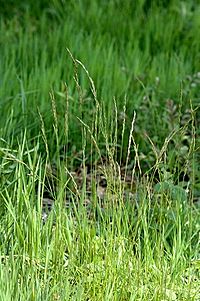Barn Hill Meadows facts for kids
| Site of Special Scientific Interest | |

Red fescue grass dominant on the site
|
|
| Area of Search | East Riding of Yorkshire |
|---|---|
| Coordinates | 53°44′57″N 0°53′48″W / 53.749139°N 0.896754°W |
| Interest | Biological |
| Area | 8.6 acres (0.035 km2; 0.0134 sq mi) |
| Notification | 1987 |
Barn Hill Meadows is a special place in the East Riding of Yorkshire, England. It's officially known as a Site of Special Scientific Interest (SSSI). This means it's protected because of its amazing nature.
The meadows are found near the town of Howden. They were given their special protection in 1987. This area sits on the flat land next to the Old Derwent river.
Barn Hill Meadows is very important for its unique grassland. This grassland is full of different herbs and has not been changed by modern farming. Many fields here have been used for making hay in the traditional way for a long time. You can even see old ridge and furrow patterns in some areas.
The main grasses you'll find growing here are red fescue and sweet vernal-grass. There are also lots of other interesting plants. These include great burnet, pepper saxifrage, and meadow cranes bill.
Contents
What Makes Barn Hill Meadows Special?
Barn Hill Meadows is a Site of Special Scientific Interest (SSSI). This title is given to places in the United Kingdom that are important for their wildlife, geology, or landforms. The main reason this site is protected is its special grassland.
Unimproved Neutral Grassland
The grassland at Barn Hill Meadows is called "unimproved neutral grassland." This means it's very natural and hasn't been changed by things like chemical fertilizers. It's also "neutral," which describes the soil type. This kind of grassland is quite rare now. It provides a home for many different plants and animals.
Traditional Farming Methods
For many years, the fields at Barn Hill Meadows have been managed in a traditional way. Farmers would cut the grass for hay. This old method helps different plants grow well. It also keeps the soil healthy.
Ridge and Furrow Features
Some parts of the meadows still show "ridge and furrow" patterns. These are wavy lines in the ground. They were created by old farming methods, often from medieval times. Farmers would plow the land in strips, creating raised ridges and lower furrows. These patterns are a cool reminder of history!
Plants You Can Find Here
Barn Hill Meadows is home to many interesting plants. The mix of grasses and wildflowers makes it a beautiful and important habitat.
Dominant Grasses
- Red fescue (Festuca rubra): This is a common grass that grows well in many places. It often forms dense patches.
- Sweet vernal-grass (Anthoxanthum odoratum): This grass has a lovely, sweet smell, especially when it's drying.
Other Important Wildflowers
- Great burnet (Sanguisorba officinalis): This plant has dark red, oval-shaped flowers that look a bit like berries.
- Pepper saxifrage (Silaum silaus): This plant has small, yellow-green flowers that grow in flat-topped clusters.
- Meadow cranes bill (Geranium pratense): This wildflower has pretty blue-purple flowers. Its seed pods look a bit like a crane's beak, which is how it got its name.
Why Protect Places Like This?
Protecting places like Barn Hill Meadows is very important. It helps to save rare habitats and the plants and animals that live there. These sites act like natural classrooms. They teach us about our environment and how different species depend on each other. By keeping them safe, we make sure future generations can enjoy them too.

